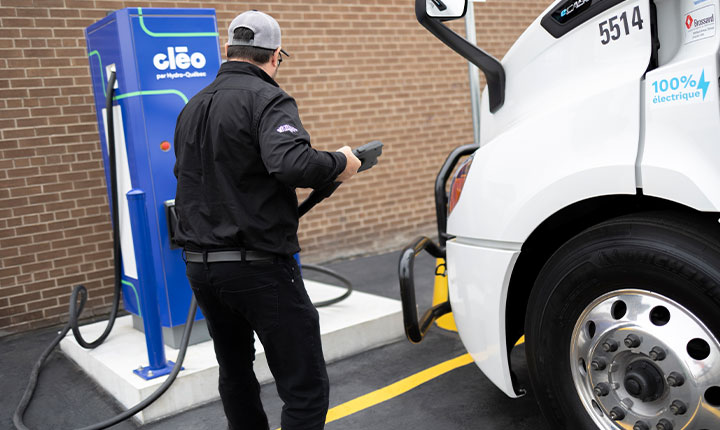Previous
You’ve probably heard various myths and preconceptions about commercial fleet electrification. Is choosing the right electric vehicle really that difficult? Does the long-term profitability of electrification outweigh the initial investment?
Let’s demystify the 8 most common industry misconceptions before you move forward with your electrification process.
Myth #1: Fleet electrification is either easy or complicated
Any electrification project needs to start with a realistic, well-thought-out plan. It helps avoid overstretching resources or setting unrealistic expectations while leaving room to adapt to unforeseen circumstances.
Electrification may seem complex, but it’s more feasible than you think! The process becomes much easier when guided by experts in the field. These specialists can streamline the transition by proposing tailor-made solutions specific to your fleet’s needs, whether it’s used to move cargo, for public transportation, or even for school transportation.
While electrification has its challenges, with proper planning and expert guidance, it’s an achievable and rewarding step toward a more sustainable future.
Myth #2: Choosing the right commercial electric vehicle can be overwhelming
There are many electric commercial vehicles to choose from, all meeting various needs. Yet, the selection process can be easily managed, especially when surrounded by experts who can help you develop an electrification strategy.
With their guidance — and a bit of time — you’ll know exactly which vehicle models to choose for your commercial fleet.
Myth #3: The cost of charging infrastructure is high
While the initial investment in electrification infrastructure may seem significant, it can be a sound financial decision in the long run. With vehicle maintenance and energy costs dropping significantly over time, electrification pays for itself. What’s more, there are innovative ways to minimize initial costs once you install the charging infrastructure!
It’s possible to lease, rather than buy, the charging infrastructure. If you decide to purchase it, several government subsidies and financial assistance programs are available to help you with your investment.
Myth #4: Electricity is cheaper than gas in Quebec
Electricity in Quebec is indeed less expensive than gas, which continues to rise at a staggering rate. However, a company’s cost per kilowatt-hour can vary depending on Hydro-Québec’s rates and the company’s consumption.
When switching to electricity, it’s important to distinguish between two fundamental concepts in Hydro-Québec billing: energy and power.
Simply put, energy is the total amount of electricity you use, while power is the rate at which you use that electricity. If electricity were water, energy would be the water you use, and power would be the rate at which you fill a bucket.
Good to know: Hydro-Québec’s pricing for business customers is based on energy consumption and maximum power demand.
For this reason, a robust charging management system is integral to your electrification journey. This system ensures that your vehicles charge during off-peak hours when electricity is cheaper, so you avoid any surprises on your bill. Remember, efficient charging management means efficient cost management!
Myth #5: You need powerful charging stations
Have you been told to choose high-capacity charging stations? Well, those are probably too powerful, expensive, and power-hungry for your needs! Repairing will also be more costly in the event of a problem.
This is where the services of transportation electrification experts come into play. Once a realistic estimate of the energy needs of your commercial vehicles has been carried out, they may suggest smaller charging stations that are less expensive to buy or lease and whose consumption will have less impact on your electricity bill.
Myth #6: Commercial vehicle charging must be done quickly
Contrary to popular belief, charging a vehicle over an extended period is an excellent idea to reduce energy costs. Otherwise, the impact on your company’s electricity bill can be significant!
What is power demand? This term refers to the amount of power a customer needs at any given moment to meet their energy demands. The power demand increases as the organization’s momentary energy consumption rises.
That’s why you must surround yourself with the right people and choose a partner that offers access to a smart charging management platform, like Cleo. To generate energy savings, you need to be able to leave your vehicle charging long enough.
Myth #7: You need to drive a fully charged vehicle
While driving a fully charged vehicle is reassuring, it’s unnecessary. After all, we don’t gas up our cars every day!
Limiting your power demand (the energy you draw from the grid over a given period) is better than only partially charging a vehicle when its capacity is sufficient for the distance you need to travel. Don’t hesitate to take advantage of a smart charging management platform: it’s a valuable tool for maximizing the potential of each vehicle and optimizing charging costs.
Myth #8: Charging stations can be repaired remotely
While some revolutionary technologies give the impression that all mechanical problems can be solved remotely, traditional manual repair is still critical. Yes, some troubleshooting can be done remotely. Still, physical endpoints often require preventive maintenance, such as filter changes and cleaning, and corrective maintenance, such as replacing parts or cables. In other words, a balanced combination of high-tech remote intervention and good old-fashioned manual labour keeps your operations running smoothly.
Join the electrification movement
By partnering with an expert like Cleo to electrify your commercial fleet, you can enjoy peace of mind while benefiting from predictable billing, minimal financial impact, and a solution that grows with your business.
Ready to get started? Contact us today!
Share
Continue reading







